Join More Than 50,000+ Subscribers and get latest camera news and rumors
NEW CAMERA VIDEOS ON YOUTUBE
|
By admin, on November 9th, 2024
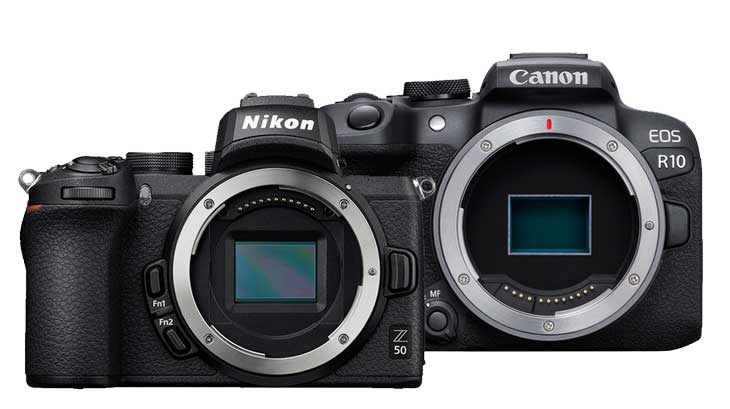
Let us compare the Nikon Z50 II with the Canon R10 camera. Let’s explore the main differences between these two cameras and find out which one is the best for photographers and which one is best for shooting videos. In the comparison table below, we have highlighted the differences in design, and we have created two separate tables dedicated to photography and videography features. So let’s find out the best camera between these two for your specific needs and budget.
1. Design Comparison
| Feature |
Nikon Z50 II |
Canon R10 |
| Body Dimensions |
5 x 3.8 x 2.6″ / 127 x 96.8 x 66.5 mm |
4.8 x 3.5 x 3.3″ / 122.5 x 87.8 x 83.4 mm |
| Weight |
495 g (Body Only) |
382.2 g (Body Only) |
| Lens Mount |
Nikon Z |
Canon RF |
| Display |
3.2″ Tilting Touchscreen LCD, 1,040,000 Dot |
3.0″ Free-Angle Tilting Touchscreen LCD, 1,040,000 Dot |
| EVF Type |
Built-In Electronic (OLED), 0.39″, 2,360,000 Dot – 1000 NITS Brightness |
Built-In Electronic (OLED), 2,360,000 Dot |
| Battery Type |
EN-EL25a or EN-EL25, approx. 230 shots |
LP-E17, approx. 430 shots |
| Ports |
USB-C Data & Power, Micro-HDMI, Mic & Headphone Jacks |
USB-C, Micro-HDMI, Mic Jack |
| Available Lenses |
Nikon Z DX and FX lenses |
Canon RF-S and RF lenses |
2. Photographic Feature Comparison
| Feature |
Nikon Z50 II |
Canon R10 |
Sensor Type
|
BSI CMOS |
FSI CMOS |
| Sensor Size |
23.5 x 15.7 mm (APS-C) |
22.3 x 14.9 mm (APS-C) |
| Effective Resolution |
20.9 Megapixel |
24.2 Megapixel |
| ISO Range (Photo) |
100 to 51,200 (Extended: 100 to 204,800) |
100 to 32,000 (Extended: 100 to 51,200) |
| Shutter Type |
Mechanical Focal Plane, Electronic Rolling |
Mechanical, Electronic Rolling |
| Shutter Speed (Mechanical) |
1/4000 to 900 sec |
1/4000 to 30 sec |
| Bulb Mode |
Yes |
Yes |
| Continuous Shooting (Mech) |
Up to 11 fps at 20.9 MP |
Up to 15 fps at 24.2 MP |
| Continuous Shooting (Elec) |
Up to 30 fps at 20.9 MP (JPEG) |
Up to 23 fps at 24.2 MP |
Pre-Capture Mode
|
1 Sec |
0.5 Sec |
| Autofocus Points |
231 (Phase & Contrast Detection) |
651 (Phase Detection Zones) |
| AF Sensitivity |
-9 to +19 EV |
-4 to +20 EV |
| AF Modes |
Continuous-Servo AF, Full-Time AF, Manual, Single-Servo AF |
Continuous-Servo AF, Manual, Single-Servo AF |
Weather sealed
|
Yes |
No |
Battery Life
|
250 Shots |
450 Shots |
3. Video Comparison
| Feature |
Nikon Z50 II |
Canon R10 |
| Sensor Type |
BSI CMOS |
FSI CMOS |
| Video Resolution & Frame Rates |
UHD 4K (30 fps) Uncropped |
UHD 4K (30 fps) Uncropped |
4k 60 FPS
|
1.5X Cropped |
1.5x Cropped |
Full HD Max Frame rate
|
120 FPS |
100 FPS |
Product showcase mode
|
Yes |
No |
| Video Stabilization |
Digital (Video Only) |
Digital (Video Only) |
| Internal Recording Codec |
H.264/H.265 (8/10-Bit) |
H.264 MP4 4:2:0 8-Bit, H.265 MP4 4:2:2 10-Bit |
| External Recording Codec |
HDMI 4K |
HDMI 1080p |
| HDR/LOG Support |
HDR-HLG, Nikon N-Log |
HDR-PQ |
Support RAW Video
|
Yes, N-Log available |
No, C-Log isn’t there |
| Recording Limit |
Up to 125 minutes |
Upto 120 Mins |
| Audio Recording |
Stereo, 24-Bit 48 kHz LPCM or 16-Bit AAC |
Stereo, 2-Channel AAC |
Conclusion Verdict
The Nikon Z50 II camera now has much-improved autofocus and also a low-light sensor, which helps to extract the maximum amount of detail possible in uncontrolled lighting environments or in any outdoor location. For wedding and event photography, we recommend you to go with Nikon Z50 II
Now, for sports and wildlife, it depends on which camera you like to buy since both are very capable. But again, due to the presence of a BSI CMOS sensor, the Z50 Mark II camera will perform better in uncontrolled lighting environments, specifically when you are using this camera for wildlife or bird photography. However, for sports events, you can take the Canon R10 with you when there is no big issue with light, as sports events generally happen during daylight. So, you may utilize the R10, and also, in sports events, you may require more reliable autofocus tracking, which is present in the Canon R10 alongside its slightly faster 15 fps mechanical shutter.
For day-to-day usage and street photography, I am going to recommend the Nikon Z50 Mark II camera. Due to the nature of its sensor and construction, the camera is able to capture clear shots and also has high low-light autofocus sensitivity compared to the R10. So more or less, for uncontrolled lighting environments of any type, the Nikon Z50 Mark II is more recommended. 165
Get a Nikon Z50 Mark II camera from the B&H Store | Amazon.com
Canon R10 – Camera body $879 [B&H Store] [Amazon.com] |
| Type of Photography/Video |
Recommended Camera |
| Wedding and Event Photography |
Nikon Z50 II
Due to its improved autofocus, low-light sensor, and availability of third-large amount party lenses , we recommend you to go with Nikon Z50 II |
| Wildlife and Bird Photography |
Nikon Z50 II
The BSI CMOS sensor in the Z50 II performs well in low-light and uncontrolled lighting, which is often required in wildlife photography. + You get AF sensitivity down to – 9 FV and upscaled 3d AI AF tracking. |
| Sports Photography (Daylight Events) |
Canon R10
Reliable autofocus tracking and slightly faster 15 fps mechanical shutter make the R10 a strong choice for sports events in daylight conditions. |
| Everyday Use and Street Photography |
Nikon Z50 II
Excellent low-light autofocus sensitivity and sensor design allow the Z50 II to capture clear shots in diverse lighting, making it versatile for daily use. |
| General Video Needs |
Canon R10 (for daylight, faster autofocus)
OR Nikon Z50 II (for low-light video) |
Nikon Z50 II Image Quality Test
Nikon Z30 / Zfc Image samples have been taken here since Nikon Z50 II and Zfc, both of them share the same sensor, so image quality is expected to remain exactly same as of the Nikon Z50 Mark II. Image credit dpreview.com
In the Image below we have compared the Nikon Z30 vs Canon R10 Images at ISO 25600, in RAW mode, as you can see the details are much preserved in Nikon Z50 II file
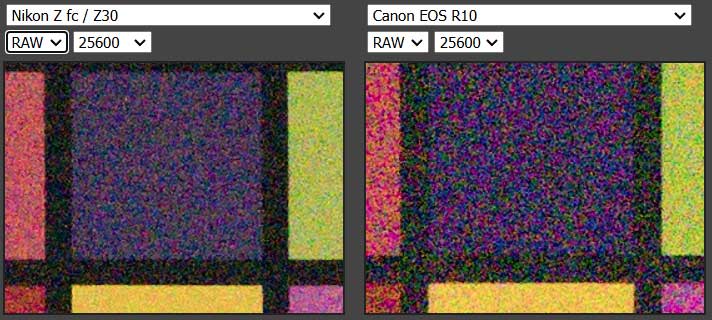
Next comparison Even in the JPEG comparison below you can see that Nikon is preserving more details compared to the Canon R10 FSI CMOS sensor.
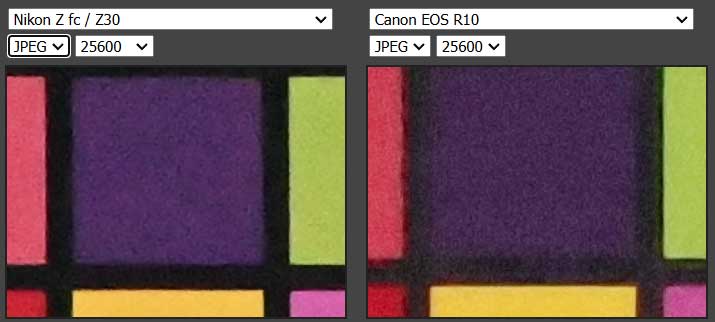
During the base ISO test we can see the letters in the Nikon Z50 II are more clearly visible than those of the Canon R10, despite having higher resolution Canon isn’t able to extract the amount of details they should at the base ISO range

In the JPEG Mode, the performance of the Canon R10 Camera is much improved which may be due to JPEG filters the Nikon Z30 sample at base ISO losing a bit of details which was visible in the RAW Mode.
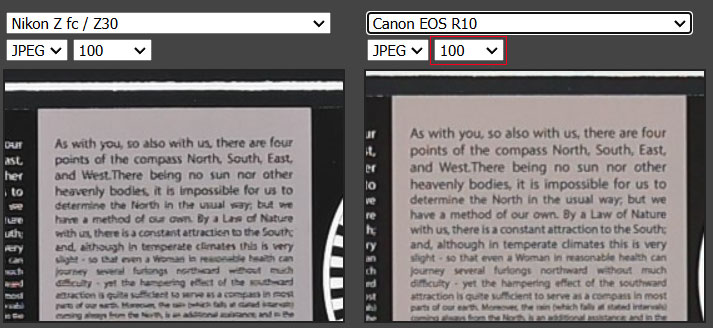
Verdict / Conclusion Image Quality
In terms of image quality, the Nikon Z50 II performs better than the Canon R10 at higher ISO settings, particularly when shooting in RAW mode. The Nikon Z50 II (or Z30) tends to capture more details at higher ISOs due to its 20MP sensor and lack of a low-pass filter, which helps to maintain fine textures.
However, at base ISO, when shooting in JPEG, the Canon R10 may show slightly more detail due to its higher 24MP resolution. But if you’re shooting in RAW at base ISO, the Nikon cameras can still provide a slightly clearer picture due to the low-pass-less design, which can enhance sharpness. Overall, for detail preservation, the Nikon Z50 II’s 20MP sensor has a slight edge, especially for those who prioritize high ISO performance and RAW shooting.
Support us – Use or affiliate link Amazon.com | B&H Store for the next purchase u make – it helps us
Follow us on our social pages FACEBOOK | TWITTER | INSTAGRAM to get live Camera News +
By admin, on November 9th, 2024
Nikon Z50 Mark II camera features the same sensor we’ve seen in other Nikon APS-C cameras, but it’s worth noting that it now has Picture Control support, custom profiles are now helping the low-light sensor to extract more and more details and better color contrast during the time of shoot, a clear example is shown below
Get a Nikon Z50 Mark II camera from the B&H Store | Amazon.com

Not only that, but the sharpness the Nikon Z50 II provides with its low-pass-less architecture is impressive, as you can see in the camera’s phenomenal circular resolving capacity in the next image.
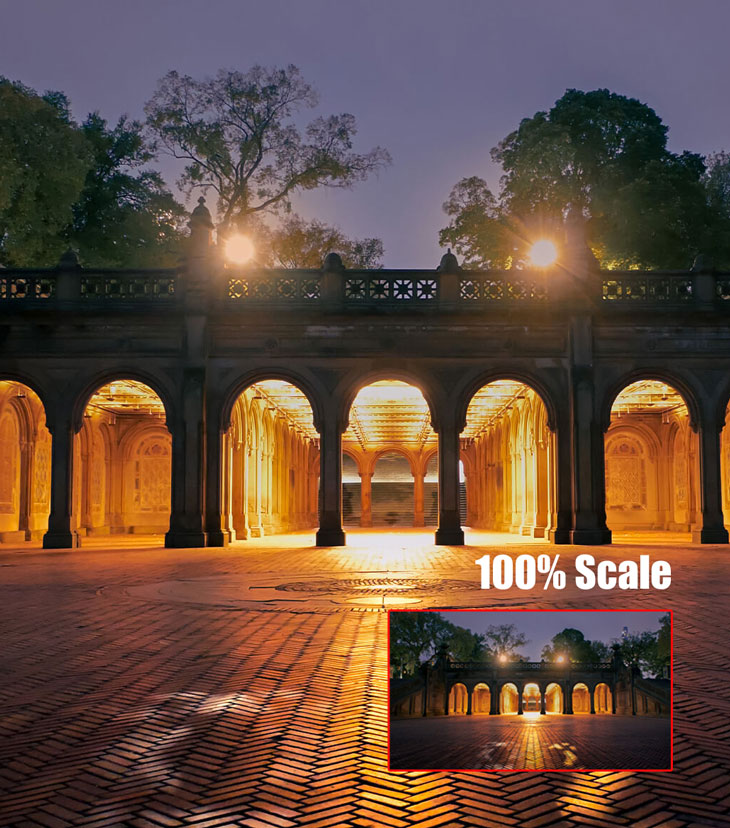
Of course, those who love high resolution may be disappointed with this release, but again… for those who love to capture images and videos in an un-controlled light environment it’s a great camera for them
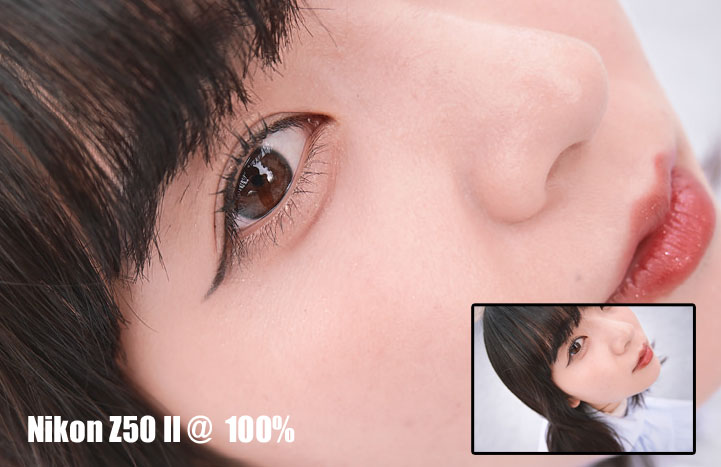
Follow us on our social pages FACEBOOK | TWITTER | INSTAGRAM to get live Camera News + Nikon Rumors 24X7
By admin, on November 7th, 2024
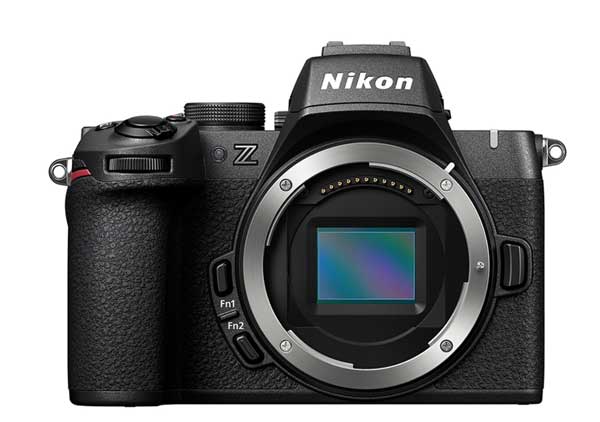
Nikon announced the long-awaited Nikon Z50 Mark II camera. If we talk about body design, we have a much-improved hand grip, which reminds us of DSLR cameras; they are very deep and very comfortable for professional hands. The other noticeable thing is a bright viewfinder of 1000 nits, despite having a 2.36 million resolution. Nikon has scaled the EVF. The other major improvement we can say in the design is the introduction of a vari-angle display screen on the rear side of the camera. As you can clearly remember, the Z50 had a tilting display screen, and now with the arrival of a vari-angle display as well as an additional audio port on the side of the camera, content creators can monitor their audio while recording videos.
Get a Nikon Z50 Mark II camera from the B&H Store | Amazon.com – Est. Ship Date: Thu Nov 21, 2024
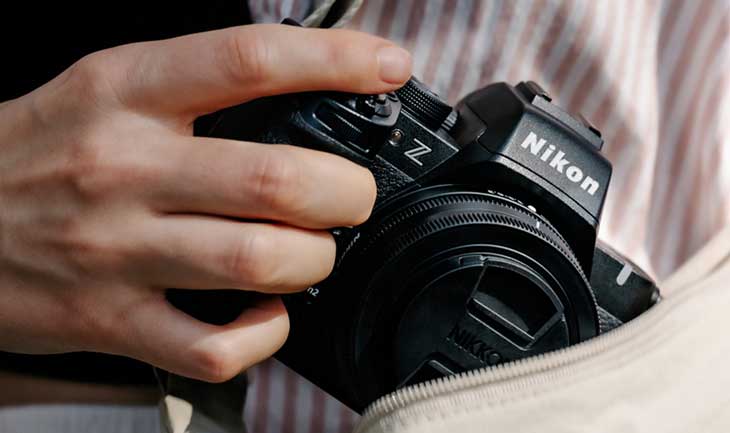
Overall Design Improvements
Overall, the camera is much improved compared to its predecessor. When we compare the designs, we see that we have a few extra controls and a newly added picture control button on top of the camera. The other noticeable advantage we have is the introduction of the EN-EL25a battery. Although it is very similar to the battery we have seen (EN-EL15) in the Z50, it has also been redesigned to run more efficiently.
Core Specifications
Now let’s talk about the internal core specifications of the camera. We have the same 20-megapixel sensor in the Nikon Z50 Mark II camera paired with the latest Expeed 7 image processor. Many users out there are disappointed with the resolution of the camera since it is the same sensor we have seen in the D500, Z30, and ZFC. All these cameras have the same, but the most interesting part of this particular sensor is its low-light performance, similar or even better to the recent current generation of higher-end APS-C cameras.
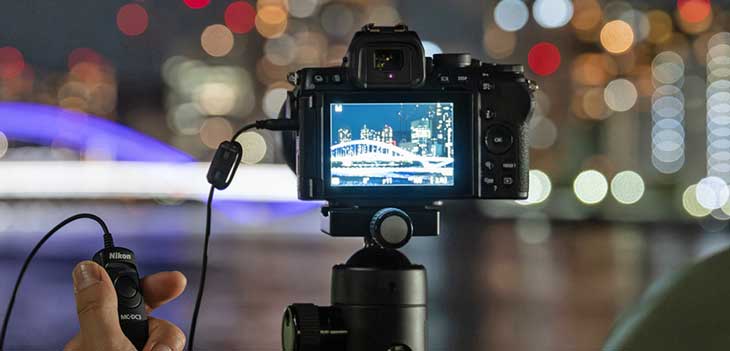
Resolution and Low-Light Performance
That said, resolution may be a completely personal choice, but having an excellent low-light-performing BSI CMOS sensor under a $1,000 budget is really impressive. I love to see the same sensor again in the Z50 Mark II body.
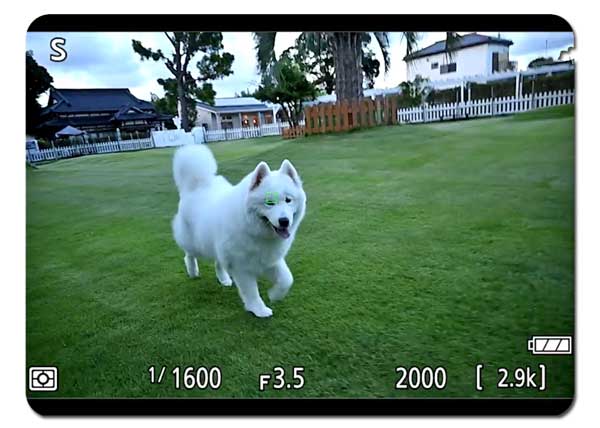
Advanced Autofocus
Now, with the introduction of the Expeed 7 image processor, we have an advanced autofocus algorithm inside the Z50 Mark II camera, which comes directly from the Nikon Z6 III and Nikon Z8 bodies. But kindly remember that Nikon’s higher-end cameras, or even the Nikon Z6 Mark III, have a partially stacked sensor, whereas the Z50 II does not have that. So the response of the AF algorithm present inside those cameras acts differently. But again, having advanced AF algorithms inside the Z50 Mark II camera enhances the autofocusing performance to the next level. The 3D auto-tracking performance keeps tracking the subject regardless of the subject or the camera movement. The other big advantage we have is the introduction of 9 different types of autofocus tracking modes. So, if we talk about the autofocus performance, the Z50 Mark II has now become one of the most advanced Nikon APS-C cameras Nikon ever announced.
Continuous Shooting Speed
The continuous shooting speed of the camera has been upscaled, and now you can shoot up to 30 frames per second with the electronic shutter. With the mechanical shutter, you can do continuous shooting up to 11 frames per second. We all know that the 20 MP BSI CMOS sensor is not a stacked CMOS sensor, so those who don’t want any kind of rolling shutter effect can select the mechanical shutter.
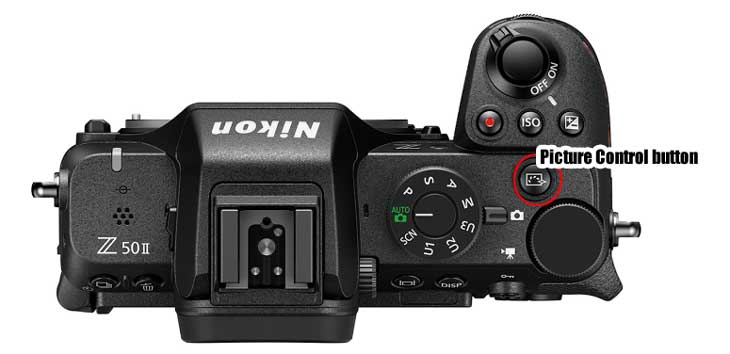
Picture Control / Profile Button and Cloud Integration
Now we have a dedicated picture profile button on the top of the camera, and with this button, you have a world of possibilities. You can browse all the presets and different kinds of picture profiles available to you through Nikon’s cloud system. Once you connect your camera with the NX software, it opens up multiple picture profiles being used by Nikon ambassadors worldwide while shooting images. So you can select any of these picture profiles for your camera and have some fun.
Video Features and Enhancements
Let’s talk about the video part of the camera. Nikon has done a lot for the video side of the camera. Starting from the design, Nikon has introduced a vari-angle display screen and a headphone port to monitor audio. Now, internally with the Expeed 7 image processor, we have an advanced 3D autofocus system for videos.
10-Bit Video Recording and Waveform
The Nikon Z50 Mark II now supports 10-bit video recording. You can record videos in 10-bit format and apply various colour profiles, including some introduced recently in Nikon’s professional cameras. Professionals will love this camera for the introduction of the waveform; now you can see the waveform functionality on the back of the camera, which helps set the exposure for the entire scene more accurately than the histogram.
Image Stabilization Drawbacks
The only thing that disappoints me is the presence of electronic image stabilization, which is not very effective in the Z50 Mark II. With VR lenses, you can achieve some stability, but it is not as good as we have seen in the Sony ZV-E10 or ZV-E10 Mark II cameras.
Here’s a straightforward table summarizing the pros and cons of the Nikon Z50 II:

Conclusion / Early Verdict
| Pros |
Cons |
| Improved Grip Design: Deep, DSLR-style grip for comfortable handling. |
Electronic Image Stabilization (EIS) Limitation: EIS is present but not as effective as IBIS or advanced stabilization systems in other brands. |
| High-Quality Vari-Angle Display: Versatile screen for flexible shooting angles, great for vlogging. |
Same 20 MP Sensor: Uses the same 20 MP sensor as its predecessor, which may disappoint users looking for higher resolution. |
| Advanced Autofocus with 3D Tracking: Enhanced AF algorithms with 9 AF tracking modes and better 3D tracking from Expeed 7 processor. |
No Significant Increase in Frame Rate for Mechanical Shutter: Mechanical shutter limited to 11 fps, which may fall short for some action photographers. |
| 10-Bit Internal Video Recording: Adds professional video quality options with 10-bit color profiles. |
|
| Enhanced Low-Light Performance: BSI CMOS sensor provides strong low-light capability for the APS-C segment. |
|
| Dedicated Picture Profile Button: Conveniently browse and apply custom profiles from Nikon’s cloud library. |
|
| Improved Battery Efficiency: Redesigned EN-EL25a battery for better performance compared to the previous Z50. |
|
By admin, on November 7th, 2024

Nikon has announced Nikon Z50 Mark II camera. The camera features the same sensor but an advanced image processor, and Nikon has done a lot of new stuff related to the design of the camera, which includes the introduction of a vari-angle display screen, a headphone port, as well as a dedicated picture control button with more custom controls over the body with an enhanced grip. A lot of improvement has been done in the autofocusing part, the continuous shooting speed, and the camera’s video features. So now, the Z50 Mark II camera can shoot up to 30 frames per second, as well as record 4K 30fps 10-bit videos and also have the RED picture profiles, waveform functionality, and all the stuff that you may wish to have in a Nikon camera. So, it is a tremendous update from Nikon under a $1000 body. But yeah, the camera still lags in image stabilization.
Nikon Z50 II Press Release
The Nikon Z50II: Master the one-touch Glow-Up with creative control of color
Nikon’s Newest Compact Mirrorless Camera Makes It Easy to Express Your Own Authentic Aesthetic
MELVILLE, NY (November 6, 2024) Today Nikon announced the new Z50II, a compact, fully featured mirrorless camera that lets your creativity run free while enabling the effortless capture of amazing photos and video. This camera is the lifestyle accessory for those that seek innovative creative features like film-inspired looks and easy sharing, giving the freedom to capture the feeling of a fleeting moment, or conveying core memories with brilliant colors that are uniquely you.
The Z50II combines a full range of fun, creativity-enhancing features with the superior performance of Nikon’s latest mirrorless technology. This is the simple to use yet powerful camera that creators will always want to bring along, whether shooting portraits, landscapes, a great night out or an epic trip. This is Nikon’s first APS-C / DX format camera to feature the powerful EXPEED 7 processing engine, the same found in the pro-grade Nikon Z8 and Z9. The Z50II makes it easier than ever to experience immersive image quality, with blazing fast and precise autofocus, fast frame rates up to 30 fps, superb low-light capabilities, advanced video features and extensive control of colors.
“If you’re ready for the next phase of your creative journey, or even if you have never picked up a camera before, the Z50II is a gateway to a whole new world of expression,” said Fumiko Kawabata, Sr. Vice President of Marketing and Planning, Nikon Inc. “This camera benefits from some of the best technology from our acclaimed pro-level cameras, but it’s small enough to tag along for anywhere life takes you.”
Discover Color
Relive the warm glow of a summer day at the beach with friends or convey the peacefully somber tones of your favorite spot in the forest. The Z50II is the first Nikon camera to feature a dedicated Picture Control button, opening new possibilities for expressive color, with imaginative film-inspired looks. In a single press, the user can see in real-time the effects of up to 31 built-in color presets, which instantly change the color, tone and feeling of the scene. Using this camera encourages the user to experiment and play with color settings to develop a truly distinct look and feel to images and video, using tones and color to evoke a feeling like never before.
Imaging Recipes can also be directly downloaded to their camera as Cloud Picture Controls directly through the Nikon Imaging Cloud. These recipes are custom presets with changes to color, brightness, hue and more, which have been developed by notable creators. Additionally, users can make their own Imaging Recipes and Flexible Picture Controls for truly limitless creative possibilities. Images can also be sent instantly to a user’s own cloud-based storage using the Nikon Imaging Cloud, or easily share images to a phone with Nikon SnapBridge.
Simply Powerful
The Z50II’s EXPEED 7 processing engine delivers surprisingly powerful performance in your pocket or purse. Advanced autofocus with nine types of subject detection quickly tracks and locks on to humans, pets, vehicles and more. The system is user-friendly and extremely precise, rapidly detecting and maintaining razor-sharp focus on a subject’s eyes, even as they move. Not only is it powerful, but it’s also smart, simplifying the operation of advanced camera functions. When in AUTO shooting mode, Nikon’s proprietary deep learning technology makes it possible for the camera to analyze and recognize the subject and scene, automatically optimizing autofocus, flash control, and exposure control values such as aperture, shutter speed and ISO sensitivity settings.
Tell Stories with Video
The Z50II empowers all types of content creators to make amazing videos that stands out, with 4K footage that’s oversampled1 from 5.6K for rich and beautiful details. The camera records in various frame rates and resolutions up to 4K60p, delivering colorful and sharp video with high-quality audio. The Z50II makes it simple to capture high-quality video with a 3.2” vari-angle LCD screen, which helps to keep you and your subjects perfectly in frame, in addition to a video self-timer to begin recording to minimize time spent editing. The Z50II also features a Product Review Mode that focuses on objects in the foreground, which is helpful for products, cosmetics, fashion and beauty reviewers.
For those looking to go to the next level in production quality, the Z50II affords full flexibility with the recording of N-Log video that offers subtle and rich tonal gradation for higher-quality video recording with more exposure latitude for grading. It also has other helpful video features like a tally lamp, waveform monitor, headphone jack and a continuous record time of up to more than 2 hours.
Features of the Nikon Z50II
- 20.9-megapixel APS-C/ DX format sensor lets you capture high quality photos and videos, with gorgeous colors and amazing low light ability.
- Dedicated Picture Control button allows for one-touch access to inspiring color presets, Imaging Recipes and custom Flexible Picture Controls, all in real-time.
- EXPEED 7 image processing engine gives users access to powerful features and performance, including an advanced AF system with subject detection and 3D Tracking.
- Bright electronic viewfinder at 1000 cd/m2 (nits), is roughly twice as bright as the one built into the Nikon Z50, allowing users to easily check focus and compose even on the brightest of days.
- Rapid photo burst shooting with up to 30 fps with electronic shutter, or up to 11 fps with the mechanical shutter.
- Features a Pre-Release Capture function capable of recording images buffered up to one second before the shutter-release button is fully pressed.
- Excellent low light capability produces sharp photos in minimal light with less grain thanks to a wide ISO range from 100–512002.
- Features made for all types of video content creators, such as N-LOG recording, product review mode, waveform monitor, microphone and headphone jacks.
- Built-in flash is useful in backlit situations as a fill-flash or in dark surroundings.
- Hi-Res Zoom3 during video recording, which allows users to zoom in on their subject with no loss in image quality, even when using a prime lens.
- An illuminated REC lamp (tally light) notifies the user and the subject when video recording is in progress.
- Support for USB streaming (UVC/UAC) allows plug and play connectivity for online meetings and live video streaming by simply connecting the camera to a computer or smartphone.
- Equipped with a large and clear 3.2-inch vari-angle monitor with a touch screen for intuitive operation and recording yourself and others.
MC-DC3 Remote Cord
The MC-DC3 is a remote cord compatible with the Z50II and later models equipped with a headphone/remote cord connector (3.5mm jack). The cord is approximately 3.1 ft/ 1m in length. It is useful in minimizing the effects of camera shake when using a tripod to photograph starry skies and nighttime scenes, or with commercial (product) photography. It can also be used for remote photography to release the shutter at a distance from the camera. The shutter-release button can be locked in the fully pressed position for long exposures (bulb shooting) or held down for continuous shooting. It can also be held halfway down for shooting with less release time-lag.
Price and Availability
The new Nikon Z50II will be available in late November 2024 for a suggested retail price of $909.95* for the body only. Kit configurations include the NIKKOR Z 16-50mm f/3.5-5.6 VR lens for $1049.95* SRP, or a two-lens kit with the 16-50mm and 50-250mm f/4.5-6.3 VR lenses for $1299.95* SRP. The MC-DC3 Remote Cord is scheduled for release later in 2024, for $36.95* SRP.
By admin, on October 22nd, 2024
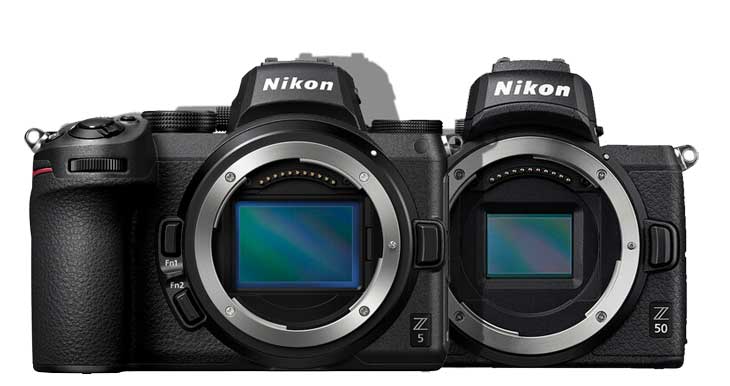
One thing is for sureᅳwe have confirmed news that the Nikon Z50 Mark II and Nikon Z5 Mark II are the next two cameras from Nikon.
The source also suggests that if everything goes as scheduled, you will be using both cameras by the end of January. I live in Asia, so if we account for shipping dates, the announcement is likely to happen in late October or the first week of November.
When asked about the possibility of a Nikon Z7 Mark III or a flagship APS-C camera like the Nikon Z80 or Z90, he said that everything would happen, but after these two announcements. First, Nikon will bring up these two baseline models, and later, they will focus on higher-end APS-C and full-frame models.
— end of rumor —
BTW, the previous tip we received with specs of the Nikon Z5 II suggested the Z5 II would be released in Jan of 2025.
Nikon Z5 Mark II Rumored Specification
24.5MP FX-Format BSI CMOS Sensor
EXPEED 7 Image Processor
UHD 4K30 Video; 1.5x 60p with crop N-Log & 10-Bit HDMI Out
5-Axis Sensor-Shift Vibration Reduction
Built-In Wi-Fi and Bluetooth
Dual SD UHS-II Card Slots
By putting all these together one thing is sure Z5 II and Z50 II both are coming.
When I asked AI to generate the possible announcement date of the upcoming Nikon Z5 II and Nikon Z50 II camera, by feeding all the latest set of information we have here is the result
Here’s a timeline of the possible announcement date of the upcoming Nikon Z50 II and Nikon Z5 II based on the typical product launch cycle, the holiday sales period, and hints from ***************:
Possible Timeline for Nikon Z50 II and Z5 II Announcements:
- Late October 2024 (Final Week):
- Announcement Window: This would be Nikon’s last chance to announce both cameras in time for the holiday season. They will likely want to create buzz right before November so that pre-orders and shipments can be processed in time for holiday sales.
- Possible Date Range: October 25-31, 2024.
- Reasoning: Nikon will want dealers and retailers to have enough time to stock the cameras for major holiday events like Black Friday (late November) and Christmas. An announcement by late October allows for marketing and logistics to ramp up.
- Early November 2024:
- Backup Announcement Window: If Nikon doesn’t hit the late October window, an early November announcement could still allow enough time for a pre-holiday push.
- Possible Date Range: November 1-7, 2024.
- Reasoning: While cutting it close to the holiday season, Nikon could still generate enough consumer interest for buyers to place pre-orders or make purchases for November’s Black Friday and Cyber Monday deals.
- Mid-November 2024:
- Less Likely, but Possible:
- Possible Date Range: November 10-15, 2024.
- Reasoning: Announcing mid-November might reduce the chances of hitting the holiday sales cycle, but Nikon could focus on early 2025 sales instead. Retailers would still be able to stock the products for last-minute holiday shoppers.
- January 2025 (CES 2025):
- Delayed Announcement (Backup Plan): If Nikon missed the holiday window of Oct and Nov entirely, the next significant event would be the Consumer Electronics Show (CES) in early January.
- Possible Date: January 8-12, 2025.
- Reasoning: CES is one of the largest tech trade shows and often used by camera manufacturers to showcase their latest products for the new year. Nikon could reveal the Z50 II and Z5 II at this event if they opt for a delayed launch.
Key Considerations:
- Final Week of October is the ideal period for Nikon to make the announcement if they want to hit holiday sales.
- November Announcements would still give retailers a chance to stock, but with less lead time.
- CES 2025 offers Nikon a strong stage if they prefer to target the new year rather than the end of 2024.
Stay tuned more updates coming
Follow us on our social pages FACEBOOK | TWITTER | INSTAGRAM to get live Camera News + Nikon Rumors 24X7
By admin, on October 3rd, 2024
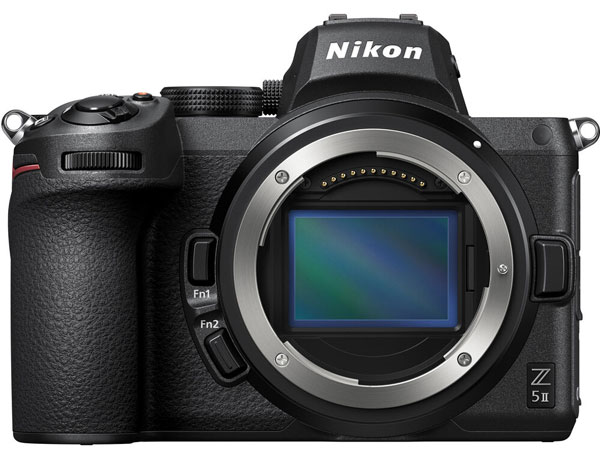
Nikon Z5 Mark II is rumored to arrive in Q1 of 2025, while there may be confusion (from our side) in understanding the shipping and announcement date, but yes the arrival of the Z5 II is certain, as per the latest rumors surfaced over the web. Take a look at the initial set of rumored specs of the Nikon Z5 Mark II camera
Nikon Z5 Mark II Rumored Specification
24.5MP FX-Format BSI CMOS Sensor
EXPEED 7 Image Processor
UHD 4K30 Video; 1.5x 60p with crop N-Log & 10-Bit HDMI Out
5-Axis Sensor-Shift Vibration Reduction
Built-In Wi-Fi and Bluetooth
Dual SD UHS-II Card Slots
stay tuned more updates are coming
Also see
Nikon First Small Step – New Luts From RED
Nikon KOMODO Z – What Can We Expect from Nikon?
Follow us on our social pages FACEBOOK | TWITTER | INSTAGRAM to get live Camera News + Nikon Rumors 24X7
By admin, on September 18th, 2024
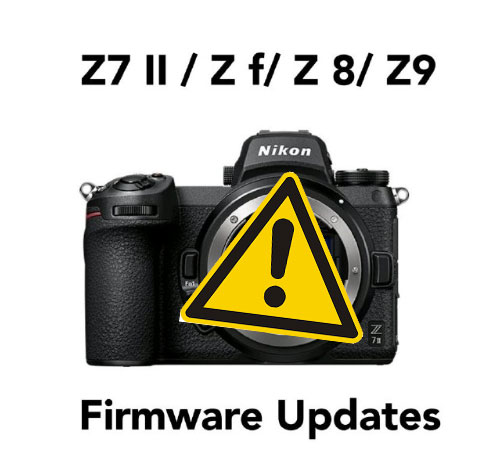
The new firmware update for Nikon Z f/ Z7 II/ Z 8/ Z 9 cameras has been delayed! The new firmware update, originally scheduled to be released months ago, has been postponed due to major issues with Nikon’s latest Z7 II firmware update and issues with Nikon Cloud.
Supporting Nikon Cloud functionality on the Z7 II camera is much more complex than originally it thought and due to that several other updates were also delayed or put on hold, which is the reason behind the delay of the new firmware. Internal testing results at Nikon have shown compatibility issues that require more time to fix. This may be unfortunate for Nikon Z7 II users, but hopefully, the new firmware released by Nikon will be rock-solid and not have frequent issues like the latest firmware from other companies, causing unnecessary trouble for users.
The new firmware for the Nikon Z f/ Z8 and Z9 cameras will significantly improve image processing capabilities. Stay tuned!
Follow us on our social pages FACEBOOK | TWITTER | INSTAGRAM to get live Camera News + Nikon Rumors 24X7.
|
KEEP THIS BLOG ALIVE - Support New Camera Buy Canon Lenses, Buy Music CD or Digital Camera at amazon it helps this site, and you do not pay anything extra, it is just a way to help support this site.

|






















